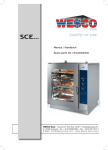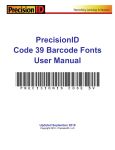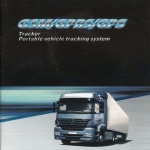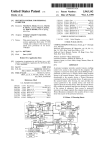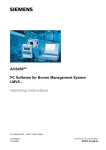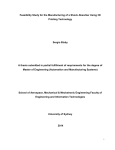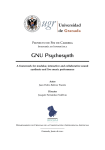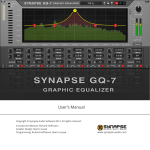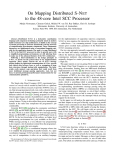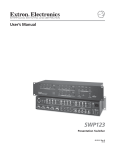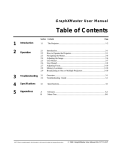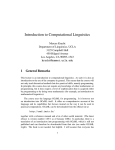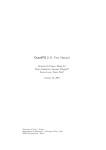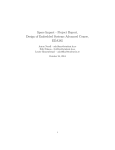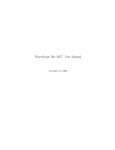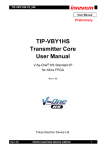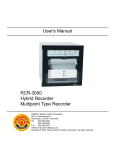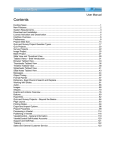Download DSL in C++ Template Metaprogram
Transcript
DSL in C++ Template Metaprogram
Zoltán Porkoláb, Ábel Sinkovics, and István Siroki
Eötvös Loránd University, Faculty of Informatics
Dept. of Programming Languages and Compilers
Pázmány Péter sétány 1/C H-1117 Budapest, Hungary
{gsd | abel | steve}@caesar.elte.hu
Abstract. We discuss a DSL integration technique for the C++ programming language. The solution is based on compile-time parsing of
the DSL code. The parser generator is a C++ template metaprogram
reimplementation of a runtime Haskell parser generator library. The full
parsing phase is executed when the host program is compiled. The library
uses only standard C++ language features, thus our solution is highly
portable. As a demonstration of the power of this approach, we present
a highly efficient and type-safe version of printf and the way it can be
constructed using our library. Despite the well known syntactical difficulties of C++ template metaprograms, building embedded languages
using our library leads to self-documenting C++ source code.
1
DSL integration
Two basic approaches exist when a DSL is about to be integrated into a host
language. In one approach some external tool or framework can be used to identify, parse, syntactically and semantically check the domain specific language
and generate the code integrated into the host language. As an alternative way
one can use internal solutions, that do not require other tools than the infrastructure of the host language. Although many of the recent DSL integration
approaches focus on the application of external tools [8][19][12][13][22], in the
case of the C++ programming language there are vital examples for using the
internal method. One of the primary candidates is template metaprogramming,
in which one can define multi-staged compilation steps using only the C++
compiler.
2
Boost.Xpressive
The Boost.Xpressive is an advanced, object-oriented regular expression library
for C++ [23]. Regular expressions are the most commonly used domain specific language among modern generic purpose programming languages. They are
used for a very special purpose, text manipulation, and have a specific, usually implementation-independent syntax. Regular expressions are usually implemented as libraries. Classical regular expression libraries, like stl::regex from
the new C++ standard, are powerful and flexible. Patterns are represented as
strings which can be specified at run-time. In this case a syntax error in the regular expression, such as unbalanced parenthesis, can be detected only at run-time.
The Boost.Xpressive library, allows an alternative way: regular expressions can
be defined using expression templates and thus they are checked at compilation
time. Regular expressions from Boost.Xpressive can either be statically bound,
hard-coded and syntax-checked by the compiler or dynamically bound and specified at run-time. These regular expressions can refer to each other recursively
and match patterns in strings that ordinary regular expressions can not.
3
Improve Xpressive using Metaparse
Xpressive is a regular expression library from Boost which gives a portable
internal solution, since it doesn’t require any external tool. It follows the second
approach we’ve mentioned in section 1.
Xpressive provides two ways for defining a regular expression (regex):
1. Dynamic Regex We can call the sregex::compile method in runtime to
create a regular expression we specified as a string. This method doesn’t
provide compile time syntax check for the regex, although it retains the
well-known syntax.
2. Static Regex We can build a regex from overloaded C++ expressions, so
called expression templates. This way we have compile time syntax checking,
but we get high syntactical overhead. For example a regular expression in
dynamic regex "(\\w+) (\\w+)!" looks like this in static regex:
(s1= + w) >> ’ ’ >> (s2= + w) >> ’!’
Our goal is to combine the best of these two approaches and give an interface
where we can specify a regex as a string with compile time syntax checking. This
way we can achieve seamless integration without syntactical overhead, thus we
don’t need to escape the domain of regular expressions when we want to use
them in C++.
This can be done with the help of the Metaparse library by writing simpler
parsers and combining them to build a more complex parser. To identify the
needed parsers we will write a grammar for regular expressions. These individual
parsers are metafunctions with a scope of parsing one element from the grammar.
They can process different regex pieces like [abc] or (xyz). We can combine
them as described in section 6, thus we can parse ([abc]xyz) too without writing
a new parser for this expression. We will show a working library which can
parse arbitrary complicated regular expressions and create the respective static
Xpressive regular expressions for them using C++ compiler only.
4
Grammar
To build a complex parser like this, we need to clearly describe how the possible
regular expression pieces can be used together. The parser needs to know the
expected order of the pieces, and how they can be embedded within each other.
The different expressions need to be categorised and ranked according to their
precedence. A grammar can express these relations.
The Xpressive User’s guide contains a table which shows line-by-line the
Perl regular expression syntax and the corresponding static Xpressive expression. We can use this table as a starting point to determine the elements the
parser needs to interpret and convert into static Xpressive objects. Note, the
POSIX character classes like [:alnum:] should be written as [[:alnum:]], if we
want to comply with the Perl syntax.
It is challenging to identify the main grammatical elements which are based
on the precedence of the expressions. We can try to draw syntax trees for concrete
expressions to identify what kind of elements we would need in the grammar to
build it up.
As we can see on figure 1, a regular expression (reg exp) consists of seq elements. These sequences consist of arbitrary number of unary item expressions
which are items with their possible repetitions. It is necessary to differentiate
items and set items, because the latter has only those expressions of the grammar which can be used within square brackets. Arbitrary number of set item
can be joined with a set element which contains the closing ’]’ character. A
character group like [abc] can be called group in our grammar and its rule can
be that it starts with ’[’ and then it continues with a set or a range expression
(range exp).
We can also identify that anything can be put in a bracket expression, so we
allow our head element to be used between ’(’ and ’)’. With different examples
we can gradually identify the use-cases of the elements, and deduce the suitable
grammar elements. The final version of our grammar can be seen in appendix A.
5
Test case generation
The test cases play a very important role in template metaprogramming. Without them, after we’ve written the code and compiled it, we can fix the obvious
syntax errors, but apart from that we haven’t instantiated any template. To test
every newly added element of the grammar we need a test case which makes
use of that element. There are many combinations of regular expressions and we
have a restriction on the format of the strings which we can add to our parsers.
A Perl script can be written to generate these test cases. This way we can ensure that whatever we match with the built Xpressive object, it would match
in Perl too. With the generated test cases, we can use the following template
function for verification:
template <c l a s s Regexp>
bool s e a r c h ( const s t d : : s t r i n g& s , const s t d : : v e c t o r <s t d : :
s t r i n g >& m)
{
const s r e g e x r e = apply wrap1<r e g e x p p a r s e r , Regexp > : :
type : : run ( ) ;
smatch w ;
const bool s u c c e s s = r e g e x s e a r c h ( s , w, r e ) ;
i f ( ( s u c c e s s && m. s i z e ( ) == 0 ) | | ( ! s u c c e s s && m. s i z e
( ) != 0 ) ) {
return f a l s e ;
}
i f (w . s i z e ( ) != m. s i z e ( ) ) { return f a l s e ; }
f or ( int i = 0 ; i < m. s i z e ( ) ; ++i ) {
i f ( i >= w . s i z e ( ) | | w [ i ] . s t r ( ) != m[ i ] ) {
return f a l s e ;
}
}
return true ;
}
A reference implementation can be found in xlxpressive’s source files [21].
We can adapt the format of the libs/xpressive/test/regress.txt file,
which contains Xpressive’s regression tests. Here is an example to show the
structure of a test case:
[ test37 ]
s t r =2001 f o o b a r
pat =[1 −9][0 −9]+\\ s ∗ [ a b f o r ]+$
f l g=
br0 =2001 f o o b a r
[ end ]
Each test case starts with its name in square brackets, then it has key-value pairs
and is closed with the [end] tag. The key-value pairs have the below meaning:
– str
The input string.
– pat
The regular expression we’re testing.
– flg
The behaviour of the Xpressive regular expression algorithm can be modified with a couple of flags e.g. ’i’ for case insensitive search.
– br0-n
br0 contains the whole matched string. Every other one comes from the
back-referencing of bracket expressions. If a test case doesn’t contain any br
element it means that we expect that the test case will fail.
6
6.1
Making parsers based on the grammar
A basic parser
After we have the grammar, we can commence building up the parsers with the
help of newer and newer test cases. Let’s start with the less complicated ones,
which are at the bottom of our syntax tree. The very first parser we’ll build is for
the caret character (’ˆ’), which has a special meaning in regular expressions. We
can put it as the first character of a sequence, which means that the following
regular expression elements should match a string from its beginning. The code
of this bos (beginning of sequence) parser is as follows:
struct b u i l d b o s
{
typedef b u i l d b o s type ;
s t a t i c x p r e s s i v e : : s r e g e x run ( ) {
return x p r e s s i v e : : bos ;
}
};
typedef metaparse : : always<
metaparse : : l i t c < ’ ˆ ’ >, x l x p r e s s i v e : : b u i l d b o s
> bos ;
The parser is built using a typedef. We can use lit c<’^’> to identify a caret
character. The always parser can be used to replace this character with our
build bos metafunction class. This class has a type, as every metafunction
class should, and a static run method. This method can be used to return the
desired static Xpressive object, which is in our case a boost::xpressive::bos
object. The eos and any elements have been created the same way.
So far so good, but how can we use this as a regular expression? We have the
’ˆ’ character identified by lit c. Our bos parser returns the build bos metafunction class, because we use the always parser. To get the static Xpressive
object we can call the run method through type, since it is static.
We have the parser we’d like to test, so we just need to give it the input
string from a test case. To do this easily Metaparse provides us a build parser
metafunction. What it does is exactly what we want: it wraps our parser with
a metafunction class which expects an input string, gives it to our parser and
returns its result. If our parser fails, a compilation error will be generated. We
use the entire input parser around our own parser to ensure that we process
the entire input string. So this is how we can use our first simple parser:
typedef metaparse : : b u i l d p a r s e r <
metaparse : : e n t i r e i n p u t <x l x p r e s s i v e : : bos>
> regexp parser ;
This can be tested with a simple test case like this:
[ test1 ]
s t r=
pat=ˆ
f l g=
br0=
[ end ]
The final step is to create an sregex object. This can be done by applying our
regexp parser on a boost::mpl::string, or we can use the MPLLIBS STRING
macro, if we can leverage the C++11 standard. For our first simple example
here’s how we can do this:
const s r e g e x r e = mpl : : apply wrap1<r e g e x p p a r s e r ,
MPLLIBS STRING( ”ˆ” ) >:: type : : run ( ) ;
To make the whole thing even more usable, we can wrap it with a macro like
REGEX. This way we can simply create our Xpressive regular expression object
(sregex) using this macro, and then we can use it the normal way:
#define REGEX( s ) ( mpl : : apply wrap1<r e g e x p p a r s e r ,
MPLLIBS STRING( s ) >:: type : : run ( ) )
const s r e g e x r e = REGEX( ”ˆ” ) ;
As we build our solution further we can add new test cases and change
the actual parser behind regexp parser to the actual top element we have
implemented so far from the grammar. This way we can test the added parser
and ensure that we haven’t broken anything.
6.2
How to build more complex parsers
After we have these basic elements we can go up a level on the syntax tree to
see how they fit into the upper element, item in this case. It looks like this in
our grammar:
item ::= set_item|bos|eos|any|bracket_exp|group
We just simply list the acceptable elements. It is important that these elements
are in the order of precedence i.e. if the first clause matches, the others aren’t
evaluated at all. We can do the same using the one of parser:
typedef metaparse : : o n e o f <
xlxpressive : : set item ,
x l x p r e s s i v e : : bos ,
x l x p r e s s i v e : : eos ,
x l x p r e s s i v e : : any ,
x l x p r e s s i v e : : bracket exp ,
x l x p r e s s i v e : : group
>
item ;
We used typedef again to create a new element of the grammar. This is a common technique to define our entities in template metaprogramming. As you can
see we’ve listed all the elements we need for a complete item. We will examine
some of them in details later on. The very similar set item can be built this
way too.
The item element with an optional repetition behind it construct the unary item,
our next target.
unary_item ::= item ((’*’|’+’|’?’|repeat) ’?’?)?
This complicated thing after item means that it can be followed by a ’*’, ’+’, ’ ?’
character or a ’repeat{n, m}’ construct. This is the repetition of item. The
’ ?’ character is optional, just like this whole repetition thing itself. Let’s see
what we want to identify and what we want that to be transformed into. On the
left side we have the regular expressions in their common format, how we use
them in Perl and on the right side the respective static Xpressive form can be
seen.
a
a*
a+
a?
a{n,m}
a*?
a+?
a??
a{n,m}?
->
->
->
->
->
->
->
->
->
a
*a
+a
!a
repeat<n,m>(a)
-*a
-+a
-!a
-repeat<n,m>(a)
The main problem here is this: we can parse an item and a repetition separately in a sequence, but how should we give the result of item to the repetition?
Let me show how we can identify these elements one-by-one, and after that how
we can solve this issue. Using a top-to-bottom approach let’s write what we want
first, break the problem into smaller parts and solve these later on:
typedef metaparse : : t r a n s f o r m <
metaparse : : sequence <x l x p r e s s i v e : : item : : type ,
x l x p r e s s i v e : : r e p e t i t i o n >,
xlxpressive : : build unary item
>
unary item ;
With sequence we can specify an order between the sub-parsers. We accept a
unary item only, if it consists of an item and then a repetition. The transform
parser will be used many times further on. It is very useful, because it calls the
second template parameter with the result of the parser in its first template
parameter, which is a sequence in our case. The second parameter is a metafunction class responsible for the transformation. We need a metafunction class
instead of a simple metafunction, because we need a type here. Metafunction
classes are complete types, so we can pass them as metafunction arguments.
They are wrappers around their publicly-accessible apply metafunction.
We have seen how the item parser can be built up. Let’s create the repetition
parser, so we’re focusing on this part of the grammar now:
((’*’|’+’|’?’|repeat) ’?’?)?
repeat ::= ’{’ (number ’,’ number|’,’ number| number ’,’) ’}’
The pipe separated list is similar to what we have seen at the item element,
so we can use the lit c and one of parser combinators again. To specify the
order between this part and the question mark character, a sequence can be
used. The numbers can be identified with the digit val parser, if we want the
int value to be returned. If we want to mark whether we’ve seen an optional
element, like ’ ?’, or not, we can use the return parser. It simply returns what is
its argument without parsing anything. We can use it with char and int values
in our case.
We have the following structure to be parsed: [*+?{](\d,\d})?’?’?. To
handle the optional parts we use the one of parser this way:
typedef metaparse : : o n e o f <
metaparse : : d i g i t v a l ,
metaparse : : r e t u r n < mpl : : i n t <−1> >
>
maybe digit ;
It can accept a digit or return -1 otherwise. If we create these parsers, we can
make the code more expressive and readable. We should do the same thing for
the comma:
typedef metaparse : : o n e o f <
metaparse : : l i t c < ’ , ’ >,
metaparse : : r e t u r n < mpl : : c h a r < ’ x ’> >
>
maybe comma ;
We parse a ’,’ character or return an ’x’. Of course, we can choose any other
character instead of ’x’ to express that we’ve not matched the expected one.
We can define maybe close curly bracket and maybe questionmark the same
way. We should have a return value in case we don’t have this repetition part
at all. For this we can create a dont repeat type, which can be defined using a
boost::mpl::vector type sequence the following way:
typedef metaparse : : r e t u r n <
mpl : : v e c t o r <
mpl : : c h a r < ’ x ’ >,
mpl : : i n t <−1>,
mpl : :
mpl : :
mpl : :
mpl : :
c h a r < ’ x ’ >,
i n t <−1>,
c h a r < ’ x ’ >,
c h a r < ’ x ’>
>
>
dont repeat ;
With these structures we can define repetition in a self-documenting manner
like this:
typedef metaparse : : t r a n s f o r m <
metaparse : : o n e o f <
metaparse : : sequence <
metaparse : : o n e o f <
metaparse : : l i t c < ’ ∗ ’ >,
metaparse : : l i t c < ’+ ’ >,
metaparse : : l i t c < ’ ? ’ >,
metaparse : : l i t c < ’ { ’>
>,
maybe digit ,
maybe comma ,
maybe digit ,
maybe close curly bracket ,
maybe questionmark
>,
dont repeat
>,
xlxpressive : : eval repetition
>
repetition ;
We’ve wrapped the whole thing with the transform parser combinator again,
because we have character and numeric values only and we need to evaluate
them and return the corresponding repetition somehow.
With eval repetition we want to give back a ”metaprogramming data”,
which shows what kind of repetition the user has specified. These are the results
of our repetition parsing and can be declared as structs e.g.:
struct n o r e p e a t { typedef n o r e p e a t type ; } ;
// when
we haven ’ t s e e n r e p e t i t i o n
struct a n y r e p e a t { typedef a n y r e p e a t type ; } ; // when
’ ∗ ’ has been i d e n t i f i e d
struct an y m ay r e p e at { typedef an y m ay r e p e at type ; } ;
// when b o t h ’ ∗ ’ and a f o l l o w i n g ’ ? ’ have been
identified
// e t c . . .
Let’s just concentrate on any repeat. How can eval repetition return it, while
it has the char and int values only? We can use the template specialization here,
because this way like with pattern matching in functional programming, we can
uniquely choose and return the needed result. eval repetition is a metafunction class. To do the pattern matching with specialization we can declare a
struct eval repetition impl which has 6 template parameters. We can pass
these parameters to the implementation by processing the sequence we’ve got
from the transform parser. The boost::mpl::at c metafunction can be used
here, since we know the length of the received sequence and we can pass the
index as a constant value:
struct e v a l r e p e t i t i o n
{
template <c l a s s Seq>
struct apply :
eval repetition impl <
mpl : : a t c <Seq , 0 >:: type
mpl : : a t c <Seq , 1 >:: type
mpl : : a t c <Seq , 2 >:: type
mpl : : a t c <Seq , 3 >:: type
mpl : : a t c <Seq , 4 >:: type
mpl : : a t c <Seq , 5 >:: type
> {};
};
::
::
::
::
::
::
value ,
value ,
value ,
value ,
value ,
value
The implementation for any repeat can be seen below. The listed constants in
the template parameters of eval repetition impl show that we’ve specialized
for the case when the user gave a ’*’ after the item. The inheritance can be
used here as a technique to return our prepared any repeat type.
template <char A, int N, char B, int M, char C, char D>
struct e v a l r e p e t i t i o n i m p l ;
template <> struct e v a l r e p e t i t i o n i m p l < ’ ∗ ’ , −1, ’ x ’ , −1,
’ x ’ , ’ x ’> : a n y r e p e a t { } ;
So this is how we can recognise the item and repetition elements. However,
to combine them in build unary item we need to slightly modify the possible
results of repetition:
// a∗ −> ∗a
struct a n y r e p e a t
{
typedef a n y r e p e a t type ;
s t a t i c x p r e s s i v e : : s r e g e x run ( x p r e s s i v e : : s r e g e x b a s e ) {
return ∗ b a s e ;
}
};
We added an sregex parameter to the run method, because the repetition
needs to use the item it stands after. In case of any repeat we return the item,
which is called base here, with a ’*’ in front of it.
typedef metaparse : : t r a n s f o r m <
metaparse : : sequence <x l x p r e s s i v e : : item : : type ,
x l x p r e s s i v e : : r e p e t i t i o n >,
xlxpressive : : build unary item
>
unary item ;
The transform parser of unary item passes the item result and the repetition
result to build unary item. So, these wrapped by the Seq type sequence become the template parameter of the apply metafunction of build unary item.
The first element of Seq is the result of the item parser, which is a sub-parser’s
builder metafunction class e.g. build bos. The second element is the repetition
data, which has a run method now. This method is the key to solve our previously described problem, namely how we can pass the previously used item
parser as a parameter of repetition. The result of parsing a repetition, like
any repeat, has a run method now, after the above modification, which has an
sregex argument.
So what the build unary item metafunction class should do is to call the
repetition’s run method with the identified sregex object from item.
struct b u i l d u n a r y i t e m
{
template <c l a s s Seq>
struct apply
{
typedef apply type ;
s t a t i c x p r e s s i v e : : s r e g e x run ( )
{
return mpl : : back<Seq > : : type : : run ( mpl : : f r o n t <Seq > : :
type : : run ( ) ) ;
}
};
};
It can call item’s static run method through its type, so this way within the
repetition’s run method we’ll have the actual, preceding sregex extracted
from the item parser.
The idea behind building these separate parsers is that we can call the run
method of our top element, which calls the lower level element’s run method
and so forth. Through these run method call-chains, we can build up more complex regular expressions from the individual parsers.
Let’s see how this works through a simple example. Suppose we want to use
the ".*" regular expression. We can use the same macro we introduced earlier:
REGEX(".*"). As you may remember this applies the ".*" boost::mpl::string
on the top level parser of our library, which can be the unary item parser now.
Here you can see the call-chain of the run methods of this example:
u n a r y i t e m : : type : : run ( )
−> b u i l d u n a r y i t e m : : apply<Seq > : : run ( )
−> return r e p e t i t i o n : : type : : run ( item : : type : : run ( ) ) ;
−> return a n y r e p e a t : : type : : run ( b u i l d a n y : : type : : run ( ) ) ;
−> return a n y r e p e a t : : type : : run ( ˜ x p r e s s i v e : : n ) ;
−> return ∗˜ x p r e s s i v e : : n ;
Just one thing left here I still owe you, the repeat elements. These differ
from the others, since they need two template parameters beside the item (’a’)
argument:
a{n,m} -> repeat<n,m>(a)
a{n,m}? -> -repeat<n,m>(a)
This is why eval repetition impl has 6 template parameters instead of just
2. We can pass N and M to the corresponding result type, (range repeat and
may range repeat), using partial template specialization:
template <char A, int N, char B, int M, char C, char D>
struct e v a l r e p e t i t i o n i m p l ;
template <int N, int M> struct e v a l r e p e t i t i o n i m p l < ’ { ’ ,
N, ’ , ’ , M, ’ } ’ , ’ ? ’> : m a y r a n g e r e p e a t <N, M> { } ;
With this solution, the may range repeat result type can directly pass its
template parameters to a boost::xpressive::repeat instantiation:
// a{n , m}? −> −r e p e a t <n , m>(a )
template <int n , int m>
struct m a y r a n g e r e p e a t
{
typedef m a y r a n g e r e p e a t type ;
s t a t i c x p r e s s i v e : : s r e g e x run ( x p r e s s i v e : : s r e g e x b a s e )
{
return −x p r e s s i v e : : r e p e a t <n , m>( b a s e ) ;
}
};
We can write range repeat the same way.
qexp has been done in a similar way, but there the always parser has been
used, because it has simpler sequences like ”i:”. Another similar parser is bschar
which processes the non-printable characters we write starting with a backslash
like ”\ n”. We need the metaprogramming result expressions there too, but we
don’t need to write a complex evaluator like eval repetition and a builder like
build unary item.
Let’s summarize what parts we have implemented so far from the grammar:
unary_item ::= item ((’*’|’+’|’?’|repeat) ’?’?)?
repeat ::= ’{’ (number ’,’ number|’,’ number| number ’,’) ’}’
item ::= bos|eos|any
bos ::= ’^’
eos ::= ’$’
any ::= ’.’
6.3
The top of the grammar
We continue to climb up the syntax tree, where the only thing left is the seq
element, before we reach the top element reg exp:
seq ::= unary_item*
This is the first expression which is built up from an arbitrary number of components. Metaparse gives us an any parser combinator which could be used in
this case, but we need to build up something from the individually processed
unary items. The foldl parser combinator suits our needs better in this case.
If you’re familiar with functional programming, you might already have an idea
what this parser could do. It tries to apply repeatedly its first template parameter, a parser. It uses the second parameter as a starting point and executes its
third argument, which is a metafunction class by giving the existing result and
the next element to that as template parameters. So, we can build something
starting from the second argument and building it using the third argument, the
metafunction which always has the last parsed element from the first argument,
which is our repeated parser.
The parser what we want to apply 0 or more times is the unary item. This
is the first parameter, the repeatedly applied parser, which consumes the input
string. The ”neutral element” of our building process is empty seq. It should
give back a kind of regular expression which matches everything, so it doesn’t
have any effect on the rest of our built expression. Xpressive doesn’t really
support something like this, but we can use the below solution. It introduces a
problem which I’m going to explain in details a bit later.
struct empty seq
{
typedef empty seq type ;
s t a t i c x p r e s s i v e : : s r e g e x run ( )
{
return x p r e s s i v e : : a s x p r ( ” ” ) ;
}
};
The foldl parser will take this element as its starting state. This means that
its ”builder” metafunction will append all the parsed elements to this, so that
they will look like this: as xpr("")>>as xpr(’a’)>>as xpr(’b’)>>.... We use
as xpr to create a static Xpressive object from the empty string. Otherwise,
it would be a normal string and we would use the usual right shift operator
with it, instead of the overloaded one. When we have an empty input string, our
result will be this empty seq.
Our third parameter is the build seq metafunction class:
struct b u i l d s e q
{
template <c l a s s Next , c l a s s S t a t e >
struct apply
{
typedef apply type ;
s t a t i c x p r e s s i v e : : s r e g e x run ( )
{
x p r e s s i v e : : s r e g e x s = S t a t e : : type : : run ( ) ;
return s >> Next : : type : : run ( ) ;
}
};
};
It gets two template parameters from foldl:
– Next
The next parsed element, which is the apply metafunction of build unary item,
so we can call its run method.
– State
The sequence we have built so far. At the beginning, it is the empty seq.
That’s why each sequence starts with as xpr("").
The built simple parser always succeeds, even if unary item rejects the input
string the very first time:
typedef metaparse : : f o l d l <
x l x p r e s s i v e : : unary item ,
x l x p r e s s i v e : : empty seq ,
xlxpressive : : build seq
>
seq ;
It iterates through our input string with foldl and processes it with the unary item
parser. After each successful parsing, it calls build seq to assemble the separate
unary items with the ”¿¿” operator. We need to use this operator for sequences,
because in static Xpressive we must use valid, overloaded C++ language constructs to build up our regular expression, that’s the main idea behind it, hence
we cannot just put things like characters next to each other i.e. we need to convert our simple ab regular expression into as xpr(a)>>b. as xpr is needed to
force the compiler to call the overloaded ”¿¿” operator and not the one for char
types.
By using foldl we’ve got a short and elegant solution, but with the any
parser we’d need to solve where and how to aggregate the sequence, which is
simply built by foldl in this case.
We can use the same technique we’ve seen at seq for our head element, reg exp.
reg_exp ::= seq (’|’ seq)*
I won’t go into too much details here, but a few things worth mentioning.
For example, we can use foldlp now, because we have at least one element in
the arbitrary long sequence. foldlp does exactly what we need here: it executes
its second argument first, a parser, and if it succeeds, it applies its first argument repeatedly, which is a parser too, and calls build reg exp to assemble the
expression:
struct r e g e x p : metaparse : : t r a n s f o r m <
metaparse : : f o l d l p <
metaparse : : l a s t o f < metaparse : : l i t c < ’ | ’ >,
x l x p r e s s i v e : : s e q >,
x l x p r e s s i v e : : seq ,
xlxpressive : : build reg exp
>,
xlxpressive : : eval reg exp
>
{};
6.4
Bracket expressions
You might have observed that we’ve declared our top element as a struct and
not used typedef. This is because we need to forward declare reg exp, so that
we can use it in the bracket expressions:
bracket_exp ::= ’(’ (reg_exp|qexp) ’)’
qexp ::= ’?’ (no_back_ref|...) reg_exp
These expressions can have two forms: (...) and (?...). The difference
between them is that the prior is the ”simple” bracket expression which saves
a back-reference for its wrapped regular expression, while the latter with the
starting ’ ?’ is for a couple special bracket wrapped constructs like (?i...) which
does case-insensitive matching within this bracket expression.
Here are a couple of these question mark prefixed expressions. On the right
side of the arrow we’ve listed what we want to generate for them:
(?i:regex)
(?>regex)
(?=regex)
(?!regex)
->
->
->
->
icase(regex)
keep(regex)
before(regex)
~before(regex)
To handle these two types, we transform them with separate builder metafunction classes and choose between them with one of. To recognize a bracket
expression we need to identify a qexp or reg exp between opening and closing
brackets. Metaparse gives us a parser called middle of which can be used for sequences with 3 elements to parse all of them, but return the result of the second
only.
typedef metaparse : : t r a n s f o r m <
metaparse : : m i d d l e o f <
metaparse : : l i t c < ’ ( ’ >,
metaparse : : o n e o f <
metaparse : : t r a n s f o r m < x l x p r e s s i v e : : qexp ,
x l x p r e s s i v e : : b u i l d q e x p b a s e d b r a c k e t e x p >,
metaparse : : t r a n s f o r m < x l x p r e s s i v e : : r e g e x p ,
xlxpressive : : build reg exp based bracket exp >
>,
metaparse : : l i t c < ’ ) ’>
>,
xlxpressive : : eval bracket exp
>
bracket exp ;
The build qexp based bracket exp and eval bracket exp metafunctions
simply call the passed type’s static run method.
However, the build reg exp based bracket exp metafunction is a bit more
interesting one. It does exactly what it says on the tin, but to build a simple bracket expression in static Xpressive, where we should give back backreferences after each bracketed expression, we need to express this intention
explicitly. We cannot simply wrap our reg exp in brackets and return it, because brackets cannot be overloaded this way. To solve this, Xpressive uses the
s1...s9 so called sub-match placeholders. So, for example to write a regular
expression like (a) in the static Xpressive world, we should do this: (s1=a).
Since we’re translating ”normal” string-based regular expressions into static
Xpressive, we don’t have the actual number of the next sub-match placeholder
which we should return. So, we need to count it ourselves.
The easiest way of doing this, if we introduce a global variable; let’s call it for
example bracket counter. We can increase its value every time when the run
method is called, before we’d return the bracket-wrapped expression. However,
it’s not a good idea to use global variables in a library, so we should come up
with a solution where our counter has local scope.
We could use the counter as a local variable in the run method, if it’s passed
as a parameter. If we take this idea as a starting-point, we’ll find that this can
actually solve our problem, if we pass the counter through the run method callchain as a reference. The very first run method which we call when we start the
evaluation of our regular expression is the one in eval reg exp. We introduce
this counter here as a local variable of the parameterless run method which calls
the overloaded one. This way we ensure that the counter will be initialized at
the start of the evaluation and that reg exp can pass an existing value forward,
if we use it in a bracket expression:
struct e v a l r e g e x p
{
template <c l a s s Re>
struct apply
{
typedef apply type ;
s t a t i c x p r e s s i v e : : s r e g e x run ( )
{
int b r a c k e t c o u n t e r = 0 ;
return Re : : type : : run ( b r a c k e t c o u n t e r ) ;
}
s t a t i c x p r e s s i v e : : s r e g e x run ( int &b r a c k e t c o u n t e r )
{
return Re : : type : : run ( b r a c k e t c o u n t e r ) ;
}
};
};
To make it work, we need to modify all the previously created parsers, so
that therun method of their build and/or evaluate metafunctions will get the
bracket counter as a reference. The only thing they should do with that is
passing it forward to the underlying parser(s), if they have any at all.
For example here’s how build seq can be modified:
struct b u i l d s e q
{
template <c l a s s Next , c l a s s S t a t e >
struct apply
{
typedef apply type ;
s t a t i c x p r e s s i v e : : s r e g e x run ( int &b r a c k e t c o u n t e r )
{
x p r e s s i v e : : s r e g e x s=S t a t e : : type : : run (
bracket counter ) ;
return s >> Next : : type : : run ( b r a c k e t c o u n t e r ) ;
}
};
};
So every parser will just get and pass the counter without modifying it, except
build reg exp based bracket exp. We can simply increase it here, evaluate the
reg exp and then choose the right sub-match placeholder with a switch-case
construct:
struct b u i l d r e g e x p b a s e d b r a c k e t e x p
{
template <c l a s s E>
struct apply
{
typedef apply type ;
s t a t i c x p r e s s i v e : : s r e g e x run ( int &b r a c k e t c o u n t e r )
{
++b r a c k e t c o u n t e r ;
x p r e s s i v e : : s r e g e x a = E : : type : : run ( b r a c k e t c o u n t e r )
;
xpressive : : sregex ret ;
switch ( b r a c k e t c o u n t e r ) {
case 1 : r e t = ( x p r e s s i v e : : s 1= a ) ; break ;
case 2 : r e t = ( x p r e s s i v e : : s 2= a ) ; break ;
// c a s e 3 . . 9 a r e s i m i l a r
}
return r e t ;
}
};
};
As I mentioned earlier, our solution for seq -where we’ve used the as xpr("")
as a neutral element in empty seq- introduced an issue. This bracket expression
is the parser where we can meet with this. Let me explain it through an example:
let’s assume that we want to use the ”(foo)” regular expression. We can do it
with our new library this way: const sregex = REGEX("(foo)"). It looks OK,
but when we try it out with our search.hpp test utility, which is used to process
each test cases we generate with gen test.pl, we get an interesting result:
success: 1
matching expected success: 1
size_check: 0 | 1 ~ 2
’foo’ VS ’foo’
sub_match: 0
RESULT: 0
It shows that our regular expression matched, and that it has the expected
behaviour. However, the sub match check failed, and this part [0 | 1 ~ 2]
shows that our solution has one less sub-match, than the expected. To find the
root-cause behind this, the best way is to debug the library, level-by-level to see
where it goes wrong. If we do this in our case we can find that at the level of
the seq parser our library doesn’t create what we would manually. This isn’t a
real problem however, but a speciality, caused by the way how we build up our
regular expressions. We should be aware of this when we use the library.
Let’s see what we generate for ”(foo)” to understand this:
sregex(as_xpr("")) >> sregex(s1= as_xpr(’f’) >>
as_xpr(’o’) >>
as_xpr(’o’))
We have an ”empty” regular expression at the front of what the user has
specified. Why this makes a difference can be found in the documentation of
Xpressive [24]. Each sregex need to have its own back-tracking scope. Regarding our solution it means that we cannot iterate through the smatch object after
a regex search, if we want to see what are the sub-matches. Instead of this, we
should call the nested results method on the smatch object which we’ve used
for the search.
Here’s an example how we can do it.
// I f s ub match and s i z e c h e c k f a i l e d , t r y t o match w i t h
nested r e s u l t s
i f ( ! sub match && ! s i z e c h e c k && w . n e s t e d r e s u l t s ( ) . s i z e
( ) > 0) {
sub match = true ;
n e s t e d r e s u l t a n a l y z e r nra (m, sub match ) ;
nra = s t d : : f o r e a c h (
w. n e s t e d r e s u l t s ( ) . begin ( ) ,
w . n e s t e d r e s u l t s ( ) . end ( ) ,
nra ) ;
s i z e c h e c k = nra . s i z e ( ) == m. s i z e ( ) ;
}
}
A reference implementation can be found in xlxpressive’s source files.
6.5
Character groups
In regular expressions we can use character groups like [a-z] or [abc], if we
want to exactly list which characters we accept in a character place. However,
we can’t list any kind of grammar elements between the square brackets e.g. we
cannot use a bracket expression there. That’s why in the grammar we’ve allowed
char group, range exp and set item only. To make it clear let me give you an
example of each, so that we can see the difference between them. On the left
side we listed the grammar elements, while in the middle we can see an example
for these elements as we would write them in a Perl regular expression. The
last column shows the static Xpressive form of the examples from the second
column.
char_group
range_exp
set_item
[[:alnum:]]
[0-9]
[aB%\w7]
alnum
range(’0’,’9’)
set[’a’ | ’B’ | _w | ’7’]
As you can see, we differentiate them, because they correspond to different kind
of Xpressive objects. They can be separated by their structure too. Each of
them starts with a ’[’ character, so we first try to parse that. If we succeed, then
according to our grammar, we have two choices: char group or set:
group
set
range_exp
set_num
num_range
set_abc
abc_range
::=
::=
::=
::=
::=
::=
::=
’[’ (char_group|’^’? set)
(range_exp|set_item)+ ’]’
number set_num|letter set_abc|set_item
’-’ num_range|set_item
number
’-’ abc_range|set_item
letter
The char group parser is the easier one. We just need to specify the sequences
of the expected letters of the character group names and choose between them
with a one of and always construct. Here’s alnum for example. All the others
have been done the same way:
typedef metaparse : : t r a n s f o r m <
metaparse : : sequence <
metaparse : : l i t c < ’ [ ’ >,
metaparse : : l i t c < ’ : ’ >,
metaparse : : o n e o f <
keyword<MPLLIBS STRING( ”alnum” ) , x l x p r e s s i v e : : alnum
>,
...
>,
metaparse : : l i t c < ’ : ’ >,
metaparse : : l i t c < ’ ] ’ >,
metaparse : : l i t c < ’ ] ’>
>,
xlxpressive : : eval char group
>
char group ;
As you can see we use a new parser called keyword here. A boost::mpl::string
can be parsed with that, which we specify as its first argument. It returns the
optional second argument, if it succeeds. We use alnum as this second argument,
which is the returned result of our parsing. It looks very much the same as
the ones for unary item we have seen previously, but we don’t need the extra
parameter for the run method.
// [ [ : alnum : ] ] −> alnum
struct alnum {
typedef alnum type ;
s t a t i c x p r e s s i v e : : s r e g e x run ( ) {
return x p r e s s i v e : : alnum ;
}
};
The run method of the eval char group metafunction returns whatever the
::type::run() method of the 3rd element of the passed Seq sequence returns,
which is the result of the one of parser. In our case, ::type::run() is called
on the alnum result, so eval char group returns boost::xpressive::alnum.
struct e v a l c h a r g r o u p
{
template <c l a s s Seq>
struct apply
{
typedef apply type ;
s t a t i c x p r e s s i v e : : s r e g e x run ( int &b r a c k e t c o u n t e r )
{
return mpl : : a t c <Seq , 2 >:: type : : run ( ) ;
}
};
};
We get the bracket counter argument in this run method, as we introduced
them in section 6.4, but we don’t pass it forward. This is because the things like
alnum are leaf elements in our syntax tree, so they return the needed objects
and don’t need to do anything with a passed extra argument.
So far so good, let’s continue with set. This grammar element introduces the
most complicated problem we cover in this thesis and needs an advanced technique to solve it. Let me describe the problem with set first and then show you
what kind of solution we can find in a case like this.
We’ve named this element of the grammar after the construct of Xpressive
we want to generate. We can define a set in multiple ways in static Xpressive:
(set= ’a’,’b’,’c’)
set[ range(’0’,’9’) |(set= ’a’,’b’,’c’) ]
set[ range(’0’,’9’) | ’a’ | ’b’ | ’c’ ]
The last form suits our needs best, because it can hold characters and range exp
elements too. The problem here is that we cannot put the objects of type
boost::xpressive::sregex returned by our parsers directly into this object.
The first thing we might think that, OK, we can try to find out what the exact type of e.g. range and return that in its run method. Unfortunately, we
can’t, because it is generated with the help of Proto [10]. This means that we
should return a type we cannot know, as it’s known by the compiler only, when
it generates it.
In C++11 we could use the redefined auto keyword [9] to let the constructor
automatically deduce the return type from the expression we return. However,
we’d like to build a C++98 compliant library as much as possible to foster wider
usability.
There is a technique we can use to solve this problem without leaving the
frames of C++98. It is called Continuation-Passing Style (CPS) [11, 15]. When
we write functions in CPS we give back the result of the function in its extra
”continuation” argument instead of in the return statement. It’s like we turn
the expression ”inside-out”, as the innermost part will be evaluated first. This
technique is useful in our case, because this extra argument of the function can
have a template type, so that we can let the compiler maintain the type of the
intermediate temporary elements. These are those types, like the type of the
range element, which we couldn’t know in advance of the compilation, because
these are generated by the compiler.
We can build up our set expression by passing the already built part as an
argument and always just appending that to the newly parsed object. To make
it work we always need to have the previous element, so that we can call its run
method with our newly constructed part. Our current parsers don’t have this
kind of functionality, so we will amend them. We need to modify only a subset
of our parsers however, since not every kind of regular expression is grammatical
within set. Based on our grammar, we need to write the range exp parser this
way and modify set item (its sub-parsers actually):
set ::= (range_exp|set_item)+ ’]’
range_exp ::= number set_num|letter set_abc|set_item
set_num
::= ’-’ num_range|set_item
num_range
::= number
set_abc
::= ’-’ abc_range|set_item
abc_range
::= letter
Each parser which can occur in set will have a common extra ”interface”
called add set item and a new run method, which is overloaded with the (T
after) argument. These methods make us able to iterate through the parsed
elements and call the previous element’s overloaded run method.
template <c l a s s T>
s t a t i c x p r e s s i v e : : s r e g e x run (T a f t e r ) {
return a f t e r ;
}
template <c l a s s B e f or e >
struct a d d s e t i t e m {
typedef a d d s e t i t e m type ;
template <c l a s s T>
s t a t i c x p r e s s i v e : : s r e g e x run (T a f t e r ) {
return B e f o r e : : type : : run ( [ c u r r e n t e l e m e n t ] | a f t e r )
;
}
};
add set item is a metafunction getting the previous parsed element as its template parameter. In the after parameter its run method gets what has been constructed after our current element. As we have what’s before [current element]
and what’s after it, we can put it right in the middle of them with the run
method call on Before. We’ll put these extra methods in the sub-parsers of
set item: bschar, number, letter and non alphabet. range exp won’t have
an argument-less run method, as it cannot be used outside set.
Let’s see how the original letter parser looks like and add the modifications
one-by-one:
struct b u i l d l e t t e r
{
template <c l a s s ch> struct apply
{
typedef apply type ;
s t a t i c x p r e s s i v e : : s r e g e x run ( int &b r a c k e t c o u n t e r ) {
return x p r e s s i v e : : a s x p r ( c h a r v a l u e ( ) ) ;
}
s t a t i c char c h a r v a l u e ( ) {
return ch : : v a l u e ;
}
};
};
typedef metaparse : : t r a n s f o r m < metaparse : : l e t t e r ,
xlxpressive : : build letter
> letter ;
We simply return the char value wrapped as a static Xpressive object. We use
a separate method called char value() here, because we’ll need it later on for
the range exp parser. First we add the overloaded run method after our original
one.
template <c l a s s T>
s t a t i c x p r e s s i v e : : s r e g e x run (T a f t e r )
{
return a f t e r ;
}
After we added this, we should add the add set item structure, which can call
it through the Before parameter.
template <c l a s s B e f or e >
struct a d d s e t i t e m {
typedef a d d s e t i t e m type ;
template <c l a s s T>
s t a t i c x p r e s s i v e : : s r e g e x run (T a f t e r )
{
return B e f o r e : : type : : run ( c h a r v a l u e ( ) | a f t e r ) ;
}
};
We’ve used the overloaded run method, and the add set item, just like how
we’ve sketched. We’ve replaced the placeholder [current element] with method
call char value(), thus we return what the normal run method returns, but
without wrapping it as an Xpressive object. This is how we can add the actually
parsed element in the form we want. In the case of letter we simply pass the
char value.
Let’s build up set. With CPS this is a two way process:
1. We parse the elements left-to-right and creating types which have the previous state and need an after parameter.
2. After we’ve parsed the last set item or range exp we have a temporary
construct, which can be evaluated backwards by calling its run method with
a neutral start value. This can be range(’4’, ’2’) as it’s an empty range.
For the iteration we can use foldl1, because we don’t accept an empty set.
This part of the parser is similar to the seq and reg exp parsers in section 6.3.
typedef metaparse : : t r a n s f o r m <
metaparse : : f i r s t o f <
metaparse : : t r a n s f o r m <
metaparse : : f o l d l 1 <
metaparse : : o n e o f < x l x p r e s s i v e : : r a n g e e x p ,
x l x p r e s s i v e : : s e t i t e m >,
x l x p r e s s i v e : : empty set ,
xlxpressive : : build set
>,
xlxpressive : : start building set
>,
metaparse : : l i t c < ’ ] ’>
>,
xlxpressive : : eval set
>
set ;
We’ve seen last of and middle of previously, first of is the one which returns
the result of the first parser after accepting a sequence. This way we can get rid
of the ’]’ easily. Let’s see what the first phase of parsing does. With foldl1 we
parse with one of the range exp and set item parsers. We’ll specify range exp
later on, so let’s just concentrate on set item now, moreover we can just use
letter instead of that.
We start building up the set with the empty set metafunction class. On the
backward way this will construct our final object we return, but in this stage
this just has a metafunction which can be called with an after parameter.
struct e m p t y s e t
{
typedef e m p t y s e t type ;
template <c l a s s T>
s t a t i c x p r e s s i v e : : s r e g e x run (T a f t e r )
{
return x p r e s s i v e : : s e t [ a f t e r ] ;
}
};
The build set metafunction class uses the add set item interface of the
actual Next element and passes the current state (State) as its template parameter. The run method of add set item is called with the after parameter.
It’s again just a metafunction, like empty set, which has to be evaluated with
an after parameter. It’s like we’re unrolling these generated metafunctions as
a ”wick” after us and when we reach the last element, we’ll light it, that is, we
work it up backward.
struct b u i l d s e t
{
template <c l a s s Next , c l a s s S t a t e >
struct apply
{
typedef apply type ;
template <c l a s s T>
s t a t i c x p r e s s i v e : : s r e g e x run (T a f t e r )
{
return Next : : template a d d s e t i t e m < S t a t e >:: type : :
run ( a f t e r ) ;
}
};
};
The ”lighter” for this string of metafunctions, to close this metaphor, is the
start building set metafunction class. The transform parser around foldl1
calls it with the result of our folding, hence we can open it up. We start the
second phase of the parsing with the empty range (e.g. range(4,2)). This is
where the CPS starts working and the method calls build up our expression in
the after argument.
struct s t a r t b u i l d i n g s e t
{
template <c l a s s R e a l S e t B u i l d e r >
struct apply
{
typedef apply type ;
s t a t i c x p r e s s i v e : : s r e g e x run ( )
{
return R e a l S e t B u i l d e r : : type : : run ( x p r e s s i v e : : r a n g e ( ’
4 ’ , ’2 ’ ) ) ;
}
};
};
The eval set metafunction class is a simple evaluator, which we’ve seen a couple
before. It can call the run method of start building set, because that doesn’t
need any parameter.
struct e v a l s e t
{
template <c l a s s Set>
struct apply
{
typedef apply type ;
s t a t i c x p r e s s i v e : : s r e g e x run ( int &b r a c k e t c o u n t e r )
{
return S e t : : type : : run ( ) ;
}
};
};
The last element of the second phase is the empty set which wraps the built
object and returns our final expression:
return boost::xpressive::set[ after ];
To see how the backward way works, let’s go through the evaluation of a
simple character group: [abc]
On figure 2 you can see how start building set commences the backward build process by calling the run method of the last build set with the
empty range. In each build set the State stores the previously processed
build set from the first phase, the Next parameter is what the current function can generate, and in the after parameter you can see how we build up
the full expression. With the return Next::template add set item< State
>::type::run(after); line, we call the run method from the add set item of
the current builder e.g. build letter.
In build letter, Before is the passed State from build set. By calling
the run method on Before (e.g. return Before::type::run( char value()
| after );) we jump to the previous build set, but with the extended after
parameter. In the last build letter we have empty set in Before, as we started
the folding with that.
We have seen how char group and set work and how the sub-parsers of
set item should be modified. Let’s see how the range exp parser looks like to
have everything to build the missing group parser.
As mentioned earlier, range exp needs the add set item interface only to be
implemented, because it cannot occur outside set. To parse a range we should
accept two kind of sequences: number - number and letter - letter.
With one of and sequence we can write this easily.
typedef metaparse : : t r a n s f o r m <
metaparse : : o n e o f <
metaparse : : sequence < x l x p r e s s i v e : : number , metaparse : :
l i t c < ’− ’ >, x l x p r e s s i v e : : number >,
metaparse : : sequence < x l x p r e s s i v e : : l e t t e r , metaparse : :
l i t c < ’− ’ >, x l x p r e s s i v e : : l e t t e r >
>,
xlxpressive : : build range
>
range exp ;
What build range should do is to put together the received results and
return the initialized range object. To extract the results from the sequence
we can use the boost::mpl::at c method again, hence we get the elements
on the 0 and 2 indices. As we only use range within a set we only define its
add set item interface.
struct b u i l d r a n g e
{
template <c l a s s Seq> struct apply {
typedef apply type ;
template <c l a s s T> s t a t i c s r e g e x run (T a f t e r ) {
return a f t e r ;
}
template <c l a s s B e f or e > struct a d d s e t i t e m {
typedef a d d s e t i t e m type ;
template <c l a s s T> s t a t i c s r e g e x run (T a f t e r ) {
return B e f o r e : : type : : run ( r a n g e ( a t c <Seq , 0 >::
type : : c h a r v a l u e ( ) , a t c <Seq , 2 >:: type : :
char value () ) | after ) ;
}
};
};
};
The newly introduced char value method of build letter and build number
have been used here. We need to do this, because the range Xpressive object
needs two char arguments.
We have written everything now to be able to parse a group. As we did so
far we follow the grammar to compose the parser.
group ::= ’[’ (char_group|’^’? set)
We’ll need a build group metafunction which simply calls the run method
of its parameter.
struct b u i l d g r o u p
{
template <c l a s s G>
struct apply
{
typedef apply type ;
s t a t i c x p r e s s i v e : : s r e g e x run ( int &b r a c k e t c o u n t e r )
{
return G : : type : : run ( b r a c k e t c o u n t e r ) ;
}
};
};
To write the group parser itself we need a sequence with the opening
square bracket as first element to be parsed and then a one of to parse either a char group or a set. The ”’^’?” part expresses that we might negate
the set construct, e.g. [^a] to match any character except ’a’. To handle this we
can use the same technique we used for unary item in section 6.2: with one of
and lit c we parse the ’ˆ’ character or we just return an ’x’ with the return
parser to express we shouldn’t negate the set. We can name it may negate with
an implementation like this:
typedef metaparse : : o n e o f <
metaparse : : l i t c < ’ ˆ ’ >,
metaparse : : r e t u r n < mpl : : c h a r < ’ x ’> >
>
may negate ;
It makes the definition of the group parser more readable.
typedef metaparse : : t r a n s f o r m <
metaparse : : l a s t o f <
metaparse : : l i t c < ’ [ ’ >,
metaparse : : o n e o f <
x l x p r e s s i v e : : char group ,
metaparse : : t r a n s f o r m <
metaparse : : sequence <
may negate ,
xlxpressive : : set
>,
xlxpressive : : eval set sign
>
>
>,
xlxpressive : : build group
>
group ;
With eval set sign we can return a positive or a negative set. It makes the
decision based on the passed character (’ˆ’ or ’x’). We can negate a set with the
’~’ operator in Xpressive. We only show the implementation of positive set,
because negative set can be done the same way with the previously described
differences.
// [ . . . ] −> s e t [ . . . ]
template <c l a s s S>
struct p o s i t i v e s e t
{
typedef p o s i t i v e s e t type ;
s t a t i c x p r e s s i v e : : s r e g e x run ( int &b r a c k e t c o u n t e r )
{
return S : : type : : run ( b r a c k e t c o u n t e r ) ;
}
};
We simply call the static run method of the received eval set result (S). It
can be this simple, because eval set sign evaluates whether we should return
a set or a negated set.
Let’s see how it can be implemented:
template <char A, c l a s s Set> struct e v a l s e t s i g n i m p l ;
template <c l a s s Set> struct e v a l s e t s i g n i m p l < ’ x ’ , Set>
: p o s i t i v e s e t <Set> { } ;
struct e v a l s e t s i g n
{
template <c l a s s Seq>
struct apply :
eval set sign impl <
mpl : : f r o n t <Seq > : : type : : value ,
mpl : : back<Seq>
> {};
};
We’ve used the same kind of pattern matching with template specialization in the
case of eval set sign impl what we’ve seen at unary item. In eval set sign,
we call type::value on the first argument of eval set sign impl, because we
want to pass the char value of may negate.
In this chapter we’ve seen how we can implement the parsers for all the main
elements of our grammar. These parsers have been created gradually following
our grammar using a bottom-to-top approach. A few examples have been shown
how these parsers can be used to generate static Xpressive objects through
run method call-chains. We’ve covered some advanced topics too e.g. how the
continuous-passing style can be used in template metaprogramming DSL integration to build grammar elements with generated types.
7
Conclusion
Our goal was to show how we can use template metaprogramming to provide
DSL embedding. The DSL we’ve chosen was Boost.Xpressive whom domain
is regular expression. It provides an approach called ”static regex” where we
can write our regex with C++ expressions. The problem is that its syntax is very
different than the original regular expression syntax. Our aim was to provide
a new interface for static Xpressive which enables us to specify compile-time
checked regular expressions as strings.
First, we’ve written a grammar for these regular expressions. Then we’ve used
this grammar to walk through the process how we can build compile time parsers
with the help of the Metaparse library. We’ve successfully built all the parsers
while we’ve encountered and solved more and more advanced problems. The
parsers created following this approach can parse separate grammar elements.
We’ve shown how the run method chain can construct a static Xpressive object.
We have created a working implementation of this library as an open source
project available on github [21]. It contains more than 40 generated test cases
showing what our solution can do at this stage.
As we’ve introduced the REGEX macro earlier, we can do a comparison to
demonstrate what our approach is capable for. The below lines show grammatically equivalent regular expressions. The first line of a block is the static
Xpressive example built by hand and the second line shows how it looks like
as an input of our new interface. The \\ characters show extra line-breaks.
(s1= +_w) >> ’ ’ >> (s2= +_w) >> ’!’;
REGEX("(\\w+) (\\w+)!");
’$’ >> +_d >> ’.’ >> _d >> _d;
REGEX("\\$\\d+\\.\\d\\d")));
bos >> set[as_xpr(’a’)|’b’|’c’|’d’] >> range(’3’,’8’) >> \\
’.’ >> ’f’ >> ’o’ >> ’o’ >> eos;
REGEX("^[abcd][3-8]\\.foo$");
bos>>(s1=+range(’0’,’9’)>>!(s2=’.’>>*range(’0’,’9’)))>> \\
(s3=set[as_xpr(’C’)|’F’])>>eos;
REGEX("^([0-9]+(\\.[0-9]*)?)([CF])$");
Our new interface is more readable and natural, while it still ensures compile
time validation. Someone who understands regular expressions should be able to
use our solution easily at the very first time, while the original interface needs
to be studied first.
As a summary we can say that using C++ template metaprogrammimg is
a good approach for embedding domain specific languages, if we construct our
own parsers with the help of the Metaparse parser combinators. These have been
created in such a way that we can easily combine them to parse our grammar
elements. With their combinations we can tackle complex problems, like the
smooth integration of regular expressions. We’ve also seen that a grammar should
be created first, if we start embedding a DSL and that how important the test
cases are, when we work on template metaprograms.
It can be subject of future works how this approach can be used for embedding other DSLs like SQL expressions or Spirit parsers.
References
1. D. Abrahams, A. Gurtovoy, C++ template metaprogramming, Concepts, Tools, and
Techniques from Boost and Beyond, Addison-Wesley, 2004, [400], ISBN-0321-22725-6
2. Y. Gil, K. Lenz, Simple and Safe SQL queries with C++ templates In: Charles
Consela and Julia L. Lawall (eds), Generative Programming and Component Engineering, 6th International Conference, GPCE 2007, Salzburg, Austria, October 1-3,
2007, pp.13-24.
3. J. Siek, A. Lumsdaine, Essential Language Support for Generic Programming, Proceedings of the ACM SIGPLAN 2005 conference on Programming language design
and implementation, New York, USA, pp 73–84.
4. C. Simonyi, M. Christerson, S. Clifford, Intentional software, In Proceedings of
the 21st annual ACM SIGPLAN conference on Object-oriented programming systems, languages, and applications, October 22-26, 2006, Portland, Oregon, USA, pp.
451465.
5. Á. Sinkovics, Z. Porkoláb, Domain-Specific Language Integration with C++ Template Metaprogramming, In Marjan Mernik (Ed): Formal and Practical Aspects of
Domain-Specific Languages: Recent Developments. Published by Information Science
Reference (an imprint of IGI Global), Hershey PA, USA. ISBN 978-1-4666-2092-6
(hardcover) - ISBN 978-1-4666-2093-3 (ebook) - ISBN 978-1-4666-2094-0 pp. 33-56.
6. Á. Sinkovics, Z. Porkoláb, Expressing C++ Template Metaprograms as Lambda
Expressions, In Zoltán Horváth, Viktória Zsók, Peter Achten, Pieter Koopman (eds):
Proceedings of Tenth Symposium on Trends in Functional Programming, Komrno,
Slovakia, 2-4 June 2009, pp. 97-111.
7. E. Unruh, Prime number computation, 1994, ANSI X3J16-94-0075/ISO WG21-462
8. Visser, E., Program Transformation with Stratego/XT: Rules, Strategies, Tools, and
Systems in StrategoXT-0.9., In C. Lengauer et al., editors, Domain-Specific Program
Generation, vol. 3016 of Lecture Notes in Computer Science, 2004, pp. 216–238.
Spinger-Verlag, June 2004.
9. The auto specified in C++11
http://en.cppreference.com/w/cpp/language/auto
10. Boost.Proto
http://www.boost.org/doc/libs/1 53 0/doc/html/proto.html
11. Continuation-passing style on Wikipedia
http://en.wikipedia.org/wiki/Continuation-passing style
12. Icon, The Icon Programming Language
http://www.cs.arizona.edu/icon
13. Katahdin
http://www.chrisseaton.com/katahdin
14. B. Milewski, Haskell and C++ template metaprogramming
http://bartoszmilewski.wordpress.com/2009/10/26/
haskellc-video-and-slides
15. B. Milewski, E. Niebler
Compile-Time/Run-Time Functional Programming in C++
http://2012.cppnow.org/session/variadic-templatemetaprogramming-using-monads
16. The MPL Reference Manual
http://www.boost.org/doc/libs/1 53 0/libs/mpl/doc/refmanual.html
17. The User Manual of mpllibs metaparse
http://abel.web.elte.hu/mpllibs/metaparse/manual.html
18. Á. Sinkovics, Z. Porkoláb,
Metaparse – Compile-time parsing with template metaprogramming
http://2012.cppnow.org/session/metaparse-compile-time-parsingwith-template-metaprogramming
19. The Stratego Program Transformation Language
http://strategoxt.org/
20. Template Haskell
http://www.haskell.org/haskellwiki/Template Haskell
21. The xlxpressive library
https://github.com/istvans/mpllibs/tree/master/mpllibs/xlxpressive
22. The XMF programming language
http://itcentre.tvu.ac.uk/clark/xmf.html
23. The User’s Guide of Xpressive
http://www.boost.org/doc/libs/1 53 0/doc/html/xpressive/
user s guide.html
24. Xpressive – ”Nested Regexes and Sub-Match Scoping” and ”Nested Results”
http://www.boost.org/doc/libs/1 53 0/doc/html/xpressive/
user s guide.html#boost xpressive.user s guide.grammars and nested
matches.nested regexes and sub match scoping
A
The grammar
reg_exp ::= seq (’|’ seq)*
seq ::= unary_item*
unary_item ::= item ((’*’|’+’|’?’|repeat) ’?’?)?
repeat ::= ’{’ (number ’,’ number|’,’ number| number ’,’) ’}’
item ::= bos|eos|any|bracket_exp|group|set_item
set_item ::= bschar|number|letter|non_alphabet
non_alphabet ::= space|’,’|’;’|’:’|’=’|’~’|’<’|’>’|
’-’|’_’|’!’|’@’|’#’|’%’|’&’|’/’
letter ::= ’A’-’Z’|’a’-’z’
number ::= ’0’-’9’
bos ::= ’^’
eos ::= ’$’
any ::= ’.’
bracket_exp ::= ’(’ (reg_exp|qexp) ’)’
qexp ::= ’?’ (no_back_ref|icase|keep|before|not_before|
after|not_after|mark_tag_create|mark_tag_use) reg_exp
no_back_ref
::= ":"
icase
::= "i:"
keep
::= ’>’
before
::= ’=’
not_before
::= ’!’
after
::= "<="
not_after
::= "<!"
mark_tag_create ::= "P<" name ’>’
mark_tag_use
::= "P=" name
name
::= letter+
bschar ::= ’\’ (bs_backslash|bs_back_ref|bs_boundary|
bs_digit|bs_word|bs_space|bs_new_line|
bs_caret|bs_dollar|bs_full_stop|bs_plus)
bs_backslash ::= ’\’
bs_back_ref ::= number
bs_boundary ::= ’b’|not_bs_boundary
not_bs_boundary ::= ’B’
bs_digit
::= ’d’|not_bs_digit
not_bs_digit ::= ’D’
bs_word
::= ’w’|not_bs_word
not_bs_word ::= ’W’
bs_space
::= ’s’|not_bs_space
not_bs_space ::= ’S’
bs_new_line ::= "r\n"|’n’
bs_caret
::= ’^’
bs_dollar
::= ’$’
bs_full_stop ::= ’.’
bs_plus
::= ’+’
group ::= ’[’ (char_group|’^’? set)
set ::= (range_exp|set_item)+ ’]’
range_exp ::= number set_num|letter set_abc|set_item
set_num
::= ’-’ num_range|set_item
num_range
::= number
set_abc
::= ’-’ abc_range|set_item
abc_range
::= letter
spaces ::= space*
space ::= ’ ’|’\n’|’\t’|’\r’
char_group ::= "[:" (’a’ set_a|’b’ set_b|’c’ set_c|’d’ set_d|
’g’ set_g|’l’ set_l|’p’ set_p|’s’ set_s|
’u’ set_u|’x’ set_x|set)
set_a
::= ’l’ set_al|set
set_al
::= ’n’ set_aln|’p’ set_alp|set
set_aln
::= ’u’ set_alnu|set
set_alnu
::= ’m’ set_alnum|set
set_alnum
::= ’:’ set_alnumT|set
set_alnumT ::= ’]’ set_alnumX|set
set_alnumX ::= ’]’
set_alp
::= ’h’ set_alph|set
set_alph
::= ’a’ set_alpha|set
set_alpha
::= ’:’ set_alphaT|set
set_alphaT ::= ’]’ set_alphaX|set
set_alphaX ::= ’]’
set_b
::= ’l’ set_bl|set
set_bl
::= ’a’ set_bla|set
set_bla
::= ’n’ set_blan|set
set_blan
::= ’k’ set_blank|set
set_blank
::= ’:’ set_blankT|set
set_blankT ::= ’]’ set_blankX|set
set_blankX ::= ’]’
set_c
::= ’n’ set_cn|set
set_cn
::= ’t’ set_cnt|set
set_cnt
::= ’r’ set_cntr|set
set_cntr
::= ’l’ set_cntrl|set
set_cntrl
::= ’:’ set_cntrlT|set
set_cntrlT ::= ’]’ set_cntrlX|set
set_cntrlX ::= ’]’
set_d
::= ’i’ set_di|set
set_di
::= ’g’ set_dig|set
set_dig
::= ’i’ set_digi|set
set_digi
::= ’t’ set_digit|set
set_digit
::= ’:’ set_digitT|set
set_digitT ::= ’]’ set_digitX|set
set_digitX ::= ’]’
set_g
set_gr
set_gra
set_grap
set_graph
set_graphT
set_graphX
set_l
set_lo
set_low
set_lowe
set_lower
set_lowerT
set_lowerX
set_p
set_pr
set_pri
set_prin
set_print
set_printT
set_printX
set_pu
set_pun
set_punc
set_punct
set_punctT
set_punctX
set_s
set_sp
set_spa
set_spac
set_space
set_spaceT
set_spaceX
set_u
set_up
set_upp
set_uppe
set_upper
set_upperT
set_upperX
set_x
set_xd
set_xdi
set_xdig
::= ’r’ set_gr|set
::= ’a’ set_gra|set
::= ’p’ set_grap|set
::= ’h’ set_graph|set
::= ’:’ set_graphT|set
::= ’]’ set_graphX|set
::= ’]’
::= ’o’ set_lo|set
::= ’w’ set_low|set
::= ’e’ set_lowe|set
::= ’r’ set_lower|set
::= ’:’ set_lowerT|set
::= ’]’ set_lowerX|set
::= ’]’
::= ’r’ set_pr|’u’ set_pu|set
::= ’i’ set_pri|set
::= ’n’ set_prin|set
::= ’t’ set_print|set
::= ’:’ set_printT|set
::= ’]’ set_printX|set
::= ’]’
::= ’n’ set_pun|set
::= ’c’ set_punc|set
::= ’t’ set_punct|set
::= ’:’ set_punctT|set
::= ’]’ set_punctX|set
::= ’]’
::= ’p’ set_sp|set
::= ’a’ set_spa|set
::= ’c’ set_spac|set
::= ’e’ set_space|set
::= ’:’ set_spaceT|set
::= ’]’ set_spaceX|set
::= ’]’
::= ’p’ set_up|set
::= ’p’ set_upp|set
::= ’e’ set_uppe|set
::= ’r’ set_upper|set
::= ’:’ set_upperT|set
::= ’]’ set_upperX|set
::= ’]’
::= ’x’ set_xd|set
::= ’d’ set_xdi|set
::= ’i’ set_xdig|set
::= ’g’ set_xdigi|set
set_xdigi
set_xdigit
set_xdigitT
set_xdigitX
::=
::=
::=
::=
’i’ set_xdigit|set
’:’ set_xdigitT|set
’]’ set_xdigitX|set
’]’
Fig. 1. The syntax tree of the ^([abc][1-5])?x$ regular expression
Fig. 2. Continuation-Passing Style






































